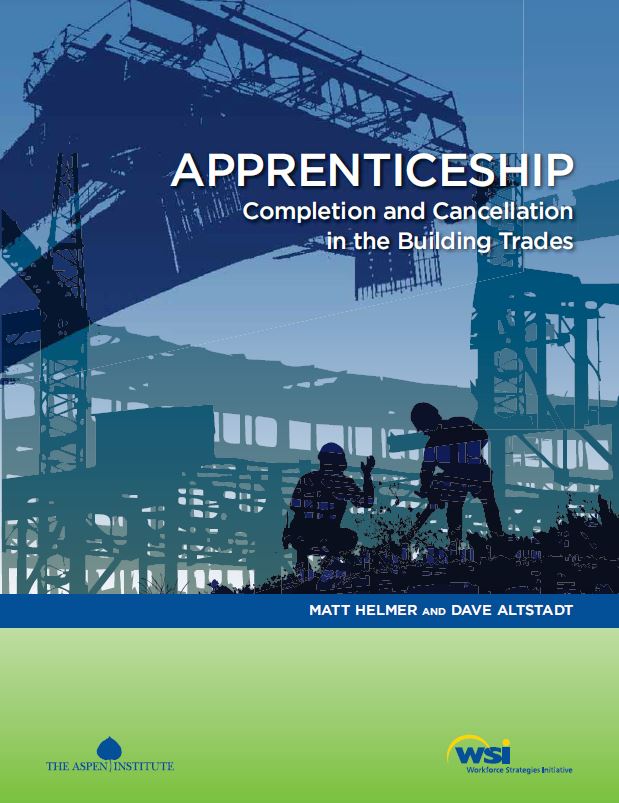Apprenticeship: Completion and Cancellation in the Building Trades
Post date
October 18, 2013
Body
Workforce Strategies Initiative, a program of the Aspen Institute executive Summary.
- Although apprenticeship completion rates vary, it is not uncommon for nearly half of construction apprenticeship agreements initiated in a given year to be cancelled.
- The Great Recession has led to high numbers of apprentices cancelling or taking longer to complete their programs.
- The majority of apprentices who cancel out of their programs do so during the first one to two years.
- The timing of cancellation for many apprentices falls within their probationary period.
- Minorities tend to cancel at higher rates than their white counterparts.
- Women cancel out of construction apprenticeships at higher rates than men.
- Apprentices with less formal education struggle to complete construction apprenticeships.
- The cancellation rate of apprentices varies by the age of apprentices when they register for their program, with those between ages 25-34 experiencing the lowest cancellation rate and highest completion rate.
- Cancellation rates differ among various construction occupations and between union and non-union programs.
- Apprentices who entered their program with advanced standing tended to complete faster and in higher percentages than those without prior credit.
- Apprenticeship completion rates in construction compare favorably to community college graduation rates.
- Several factors can make completing an apprenticeship challenging.
- Apprenticeship completion is achievable if the right attitude, work environment and supports are in place.
- Policymakers should invest in infrastructure projects that not only address growing concern about the condition of our nation’s infrastructure, but also keep more apprentices employed and in training, ensuring that our nation has a reliable construction workforce in the decades ahead.
- Policymakers should invest more resources to collect better data on apprentice outcomes, the reasons why apprentices cancel, and the different preparation, training and support strategies that lead to the best outcomes.
- Policymakers should make public resources such as Workforce Investment Act (WIA) funds more accessible to apprenticeship programs to help provide support services to apprentices.
- Policymakers and investors should more strongly support pre-apprenticeship programs to improve long-term supports to apprentices.
- Investors and policymakers should help support, develop, and evaluate more mentoring and retention efforts, as well as encourage experimentation in strategies that support apprenticeship completion.
- Pre-apprenticeship programs should build networking and mentoring opportunities for apprentices they place, and strivee to support apprentices through the first year of their apprenticeship.
- Apprenticeship programs should build in extra supports for the development of apprentices’ math skills.
- Apprenticeship programs should experiment with flexiable training options.
- Apprenticeship programs and industry leaders should increase oversight of OJT and job rotations.
- Apprenticeship programs and industry leaders should develop processes to fairly evaluate and provide credits toward an apprenticeship to apprentices with prior work or classroom experience.
- Apprenticeship programs and industry leaders should continue to foster a culture in the workplace and industry that does not tolerate abusive hazing or harassment, particularly of women and minorities.
- Apprenticeship programs should also do more to leverage resources from preapprenticeship programs, community colleges and other community resources to help address the various barriers apprentices face.
- Apprenticeship programs and industry stakeholders should develop more mentoring projects.
- Policymakers, investors and industry should work together to create more awareness among young adults, women, and minorities of apprenticeship and construction careers.


